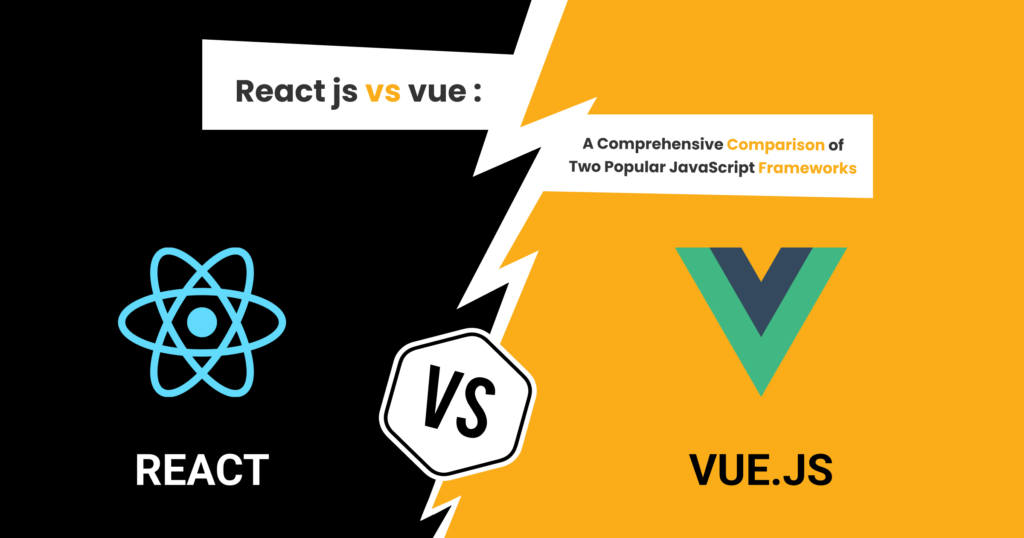Introduction to react js vs vue
Are you ready to dive into the world of react js vs vue JavaScript frameworks? In this fast-paced digital era, developers must choose the right tools that can help them build robust and dynamic web applications. react js vs vue have emerged as two popular choices among developers worldwide. Whether you’re a seasoned developer or just starting your coding journey, understanding the similarities, differences, pros, cons, and use cases of these frameworks is essential. So buckle up as we embark on a comprehensive comparison between React JS and Vue – two powerhouses in the JavaScript framework universe!
Similarities between react js vs vue
React JS and Vue are both popular JavaScript frameworks that have gained significant traction in the web development community. Despite their differences, they share some similarities that make them powerful tools for building modern user interfaces.
One of the key similarities between React JS and Vue is their component-based architecture. Both frameworks allow developers to create reusable components, which can be easily composed together to build complex UIs. This modular approach promotes code reusability and makes it easier to manage large-scale projects.
Another similarity is the use of a virtual DOM (Document Object Model). Both React JS and Vue employ a virtual representation of the actual DOM, which allows for efficient updates by only rendering changes rather than updating the entire DOM tree. This results in improved performance and smoother user experiences.
Additionally, React JS and Vue offer robust ecosystems with extensive libraries and tooling support. They both have thriving communities that contribute to an ever-growing collection of third-party packages, making it easier for developers to add functionality or solve specific problems.
Furthermore, React JS and Vue emphasize declarative programming paradigms. Developers can describe what they want their UIs to look like based on changing data states without worrying about how those changes will be implemented under the hood. This leads to cleaner codebases that are easier to understand and maintain over time.
While there may be differences between React JS and Vue in terms of syntax or learning curve, these two JavaScript frameworks share important commonalities, such as component-based architecture, virtual DOM usage, expansive ecosystems, and a focus on declarative programming principles. These shared traits contribute to their popularity among developers seeking efficient ways to build dynamic user interfaces.

Differences between react js vs vue in terms of syntax, performance, and learning curve
Syntax plays a crucial role when choosing a JavaScript framework. React JS uses JSX (JavaScript XML), which allows developers to write HTML-like code directly within their JavaScript files. This can make the code more readable and easier to understand for those familiar with HTML. On the other hand, Vue uses a template-based syntax that separates HTML markup from JavaScript logic, making it easier to maintain and reuse components.
When it comes to performance, both React JS and Vue have their strengths. React JS is known for its virtual DOM (Document Object Model), which optimizes rendering by comparing changes in data and updating only what needs to be updated. This makes React highly efficient for complex applications with large amounts of data. On the other hand, Vue’s reactivity system allows it to efficiently track changes in data without the need for a virtual DOM.
In terms of the learning curve, many developers find React JS slightly more challenging due to its use of JSX and its reliance on creating reusable components manually. However, once you grasp these concepts, building robust applications becomes smoother. In contrast, Vue has been praised for its gentle learning curve, as it offers clear documentation and an intuitive API that simplifies component creation.
While there are differences in syntax, performance capabilities, and learning curves between React JS and Vue, both frameworks offer powerful solutions for developing modern web applications. It ultimately boils down to personal preference or project requirements when deciding which one suits your needs best.
Pros and Cons of using React JS and Vue
React JS and Vue are both popular JavaScript frameworks that offer several advantages and have their own unique set of pros and cons.
One major advantage of using React JS is its virtual DOM, which allows for efficient rendering by only updating the necessary components. This results in improved performance, especially when dealing with complex applications. Additionally, React JS has a large developer community, extensive documentation, and plenty of third-party libraries available for easy integration.
On the other hand, Vue offers a simpler syntax compared to React JS. It adopts an HTML-like template syntax that makes it easier to understand and write code. Vue also provides better out-of-the-box support for form handling and animations. Furthermore, Vue’s component-based architecture allows for reusability and better organization of code.
However, one drawback of React JS is its steep learning curve. Beginners might find it challenging to grasp concepts like JSX or Flux architecture initially. In contrast, Vue has a gentle learning curve due to its simplicity.
Another aspect worth considering is the size of the ecosystem surrounding each framework. While React JS has a larger community base contributing to continuous improvement and innovation, Vue also boasts an active community that actively supports development efforts.
Choosing between React JS or Vue depends on your project requirements, such as complexity level, team expertise levels, and specific use cases you need to address.
Use cases for react js vs vue
React JS and Vue are both powerful JavaScript frameworks that have a variety of use cases. Let’s explore some of the common scenarios where each framework shines.
Companies such as Facebook, Instagram, Airbnb, and Netflix commonly use React JS to build highly dynamic and interactive interfaces for their web applications. React excels in creating reusable components, making it ideal for large-scale projects with complex UI components..
On the other hand, Vue is known for its simplicity and ease of integration into existing projects. It is often chosen for smaller applications or when developers prefer a more gradual adoption process. Vue’s flexibility makes it suitable for building single-page applications (SPAs), progressive web apps (PWAs), or even mobile apps using tools like NativeScript or Weex.
Both frameworks can handle real-time updates efficiently through their virtual DOM implementations. This makes them great choices when developing real-time collaboration tools, chat applications, dashboards with live data feeds, or any application requiring near-instantaneous data rendering.
Another area where React JS shines is e-commerce websites. Its ability to manage complex state changes quickly allows for seamless shopping experiences with features like filtering products based on multiple criteria or dynamically updating product availability.
Vue has gained popularity in the content management system (CMS) space due to its ease of integration with existing systems. Developers often choose Vue when they need to create custom admin panels or extend functionality within popular CMS platforms like WordPress.
While React JS excels in large-scale applications requiring complex UIs and real-time updates, Vue offers simplicity and flexibility, which make it an excellent choice for smaller projects or integrating into existing systems seamlessly.

Community support and job opportunities for both frameworks
Community support and job opportunities are important factors to consider when choosing a JavaScript framework. Both React JS and Vue have strong communities backing them, providing users with ample resources and assistance.
React JS has a large and active community that is constantly growing. It is backed by Facebook, which means there is plenty of documentation, tutorials, and online forums available for developers to seek help from. The React community also regularly releases updates and improvements to the framework, ensuring its continued relevance in the industry.
Similarly, Vue boasts a supportive community that is passionate about the framework. Although smaller than React’s community, Vue’s user base continues to expand rapidly. The community provides extensive resources such as official documentation, forums, meetups, and conferences where developers can share their knowledge and learn from others.
When it comes to job opportunities, both React JS and Vue offer promising prospects for developers. As two of the most popular JavaScript frameworks in today’s market, companies are actively seeking professionals skilled in these technologies. Job boards are filled with listings for React or Vue developers across various industries.
Overall, react js vs vue
Conclusion: Which Framework Should You Choose?
After a comprehensive comparison of React JS and Vue, it’s clear that both frameworks have their strengths and weaknesses. So, which one should you choose for your next project? Well, the answer largely depends on your specific requirements and preferences.
If you prefer a more lightweight framework with simpler syntax and a faster learning curve, Vue might be the way to go. With its intuitive template syntax and easy-to-understand concepts, Vue can help you quickly build interactive user interfaces without overwhelming complexity. It also offers great performance out of the box due to its optimized rendering process.
On the other hand, if you are working on a large-scale application or need better performance optimization options, React JS could be the better choice. Its virtual DOM implementation allows for efficient updates to minimize re-rendering of components. Additionally, React’s extensive ecosystem provides numerous third-party libraries and tools that can enhance development productivity.
When it comes to community support and job opportunities, both React JS and Vue have strong communities backing them up.
However, major tech companies like Facebook and Instagram have widely adopted React, which has been around longer than Vue. This implies more job opportunities for developers with React skills compared to Vue proficiency.
In conclusion (without saying “in conclusion”), while there isn’t a definitive winner between React JS vs Vue as each has its own merits depending on your project needs, it is important to carefully evaluate your requirements before making a decision. Consider factors such as project size, performance demands, learning curve tolerance, developer familiarity, or preference when choosing between these two popular JavaScript frameworks.
Ultimately, though (without using “finally”), regardless of whether you choose React JS or Vue as your preferred framework – remember that continuous learning is key in staying up-to-date with new developments in web technologies!

